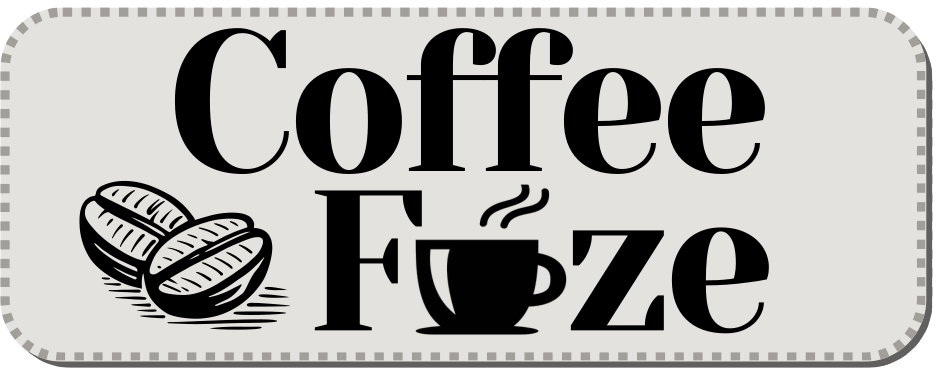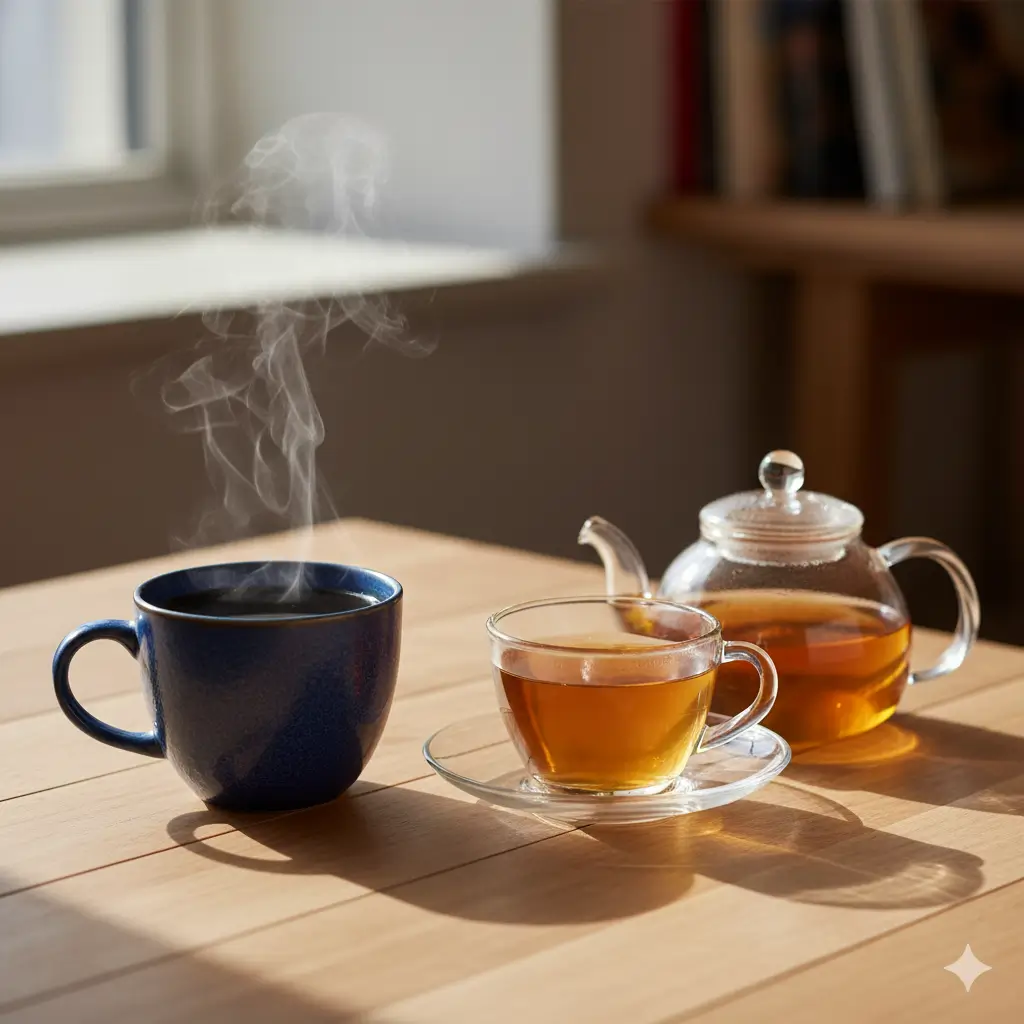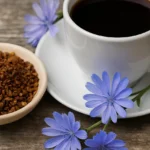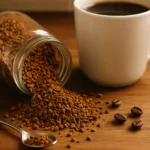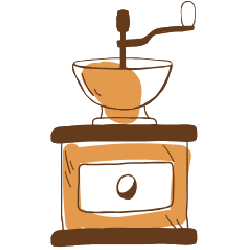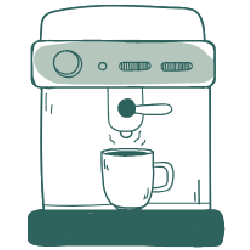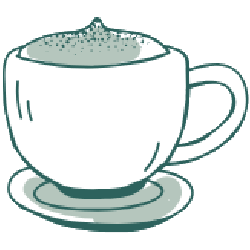Ever wondered if your morning coffee gives you more of a kick than your afternoon tea? Most times, coffee packs a bigger caffeine punch than tea. But here’s the thing: how much caffeine you actually get from either drink changes a lot depending on several things. Knowing these differences helps you keep tabs on your daily caffeine, giving you better energy and health.
- How much caffeine is typically in coffee vs tea?
- Typical caffeine levels in different drinks
- What makes your coffee’s caffeine content change?
- How do coffee bean types change caffeine?
- Do brewing methods and grind size impact coffee caffeine?
- What about roast, water temperature, and brewing time?
- What changes caffeine levels in tea?
- How do tea type and processing affect caffeine?
- Do brewing temperature and time change tea caffeine?
- What about the leaf itself – age, type, and form?
- Why does matcha have so much more caffeine than other teas?
- Health benefits and things to consider about caffeine
- What are coffee’s caffeine health benefits?
- What are the health benefits of tea caffeine and polyphenols?
- What are the possible side effects of caffeine, and why does everyone react differently?
- How much caffeine should you have each day, and when is it too much?
- How much caffeine should healthy adults drink daily?
- Caffeine limits for pregnant women, children, and teens
- What other drinks have caffeine?
- How do you choose between coffee and tea for your caffeine?
- The main point about coffee and tea caffeine
How much caffeine is typically in coffee vs tea?
When you look at similar serving sizes, coffee usually has more caffeine than tea. A regular 8-ounce cup of coffee, for example, often has around 80 to 100 milligrams (mg) of caffeine. An 8-ounce cup of tea, on the other hand, usually falls somewhere between 20 and 70 mg. That means your coffee often gives you about twice the caffeine of a black tea.
Typical caffeine levels in different drinks
Caffeine levels really jump around, even within the same type of coffee or tea. Take a look at this breakdown for an average 8-ounce serving of popular drinks. Just remember, espresso is super concentrated, so you drink it in much smaller sips.
| Beverage | Average Caffeine Content (8-ounce serving) | Notes |
|---|---|---|
| Brewed Coffee | ~95 mg (range 90-200 mg) | Greatly depends on bean type, roast, and brewing method. |
| Black Tea | 40-70 mg | Generally the highest among traditional steeped teas. |
| Green Tea | 20-45 mg | Offers moderate caffeine levels and L-theanine. |
| Espresso | ~63 mg (per 1 ounce shot) | Highly concentrated, typically consumed in smaller amounts. |
| Oolong Tea | 30-40 mg | Caffeine content falls between green and black tea. |
| White Tea | 15-30 mg | Generally the lowest caffeine among traditional teas. |
| Herbal Teas | 0 mg (negligible) | Naturally caffeine-free infusions. |
| Matcha | Much higher (whole leaf consumed) | A strong bowl can contain 70 mg or more. |
What makes your coffee’s caffeine content change?
The amount of caffeine in your coffee isn’t always the same; a few big things decide it. These factors explain why coffee caffeine levels vary so much. Knowing them helps you guess how much of a jolt you’ll get.
How do coffee bean types change caffeine?
The type of coffee bean matters most for caffeine. Robusta beans (Coffea canephora) usually have about twice the caffeine of Arabica beans (Coffea arabica). This big difference means a cup made from Robusta will naturally be stronger than an Arabica one.
Do brewing methods and grind size impact coffee caffeine?
How you brew your coffee and how fine you grind it really change how much caffeine ends up in your cup. Methods like espresso or French press pull out more caffeine. That’s because they either have longer contact with the water or use pressure. Finer grinds also mean more surface area touches the water, so you get more caffeine out than with coarser grinds.
What about roast, water temperature, and brewing time?
Yes, roast level, water temperature, and brewing time all affect your coffee’s caffeine content. They matter less than the bean type or brewing method, though. Darker roasts usually have a bit less caffeine by weight than lighter roasts because some caffeine breaks down during roasting. Hotter water pulls more caffeine from the grounds than cooler water. Longer brewing times also extract more caffeine, but the overall difference in your cup is often pretty small.
What changes caffeine levels in tea?
Tea’s caffeine content can swing even more wildly than coffee’s. Your cup’s final caffeine level really depends on the type of tea, how they processed it, how you brew it, and even which part of the tea plant they used. Knowing these things helps you understand why teas have such different caffeine amounts.
How do tea type and processing affect caffeine?
The type of tea and how they process it directly change its caffeine levels. Black tea, for example, is fully oxidized and usually has the most caffeine among steeped teas. Green tea gets minimal oxidation, so it has moderate caffeine. White tea, processed very little, often has the least caffeine. Oolong tea, partly oxidized, sits somewhere between green and black teas in its caffeine.
Do brewing temperature and time change tea caffeine?
Brewing temperature and how long you steep your tea are huge for getting caffeine out of the leaves. Hotter water means more caffeine dissolves into your drink. Steeping it longer also releases more caffeine. Think about black tea – you often steep it hotter and longer, which adds to its generally higher caffeine content per cup.
What about the leaf itself – age, type, and form?
The tea plant’s natural traits and how they prepare the leaves also play a role. Younger leaves and buds, often found in high-quality white teas, hold more caffeine than older, bigger leaves. Different tea plant cultivars, such as Camellia sinensis var. assamica (found in Assam teas) versus Camellia sinensis var. sinensis (Chinese teas), naturally have different caffeine potentials. Plus, broken or crushed leaves, like those in teabags, release caffeine faster because they have more surface area than whole leaves.
Why does matcha have so much more caffeine than other teas?
Matcha, which is a powdered green tea, has way more caffeine than your average steeped tea. Why? Because you’re actually drinking the whole tea leaf, ground into a fine powder. So you take in all the caffeine and other good stuff from the leaf, not just what dissolves in the water. That gives you a much stronger boost.
Health benefits and things to consider about caffeine
Caffeine, whether from coffee or tea, comes with its own set of benefits and things to think about. Both drinks also have other good compounds, like antioxidants and polyphenols, which help their unique health stories. Knowing these differences helps you choose what’s best for you and handle any caffeine side effects.
What are coffee’s caffeine health benefits?
Coffee caffeine brings some pretty well-known health benefits to the table. If you drink coffee in moderation – say, 3-5 cups a day – you might see reduced risks for some chronic diseases:
- a lower risk of heart disease,
- less chance of type 2 diabetes,
- protection against fatty liver disease,
- a decreased risk of depression,
- and slowed cognitive decline.
These positive effects come from both the caffeine and other helpful compounds in your coffee.
What are the health benefits of tea caffeine and polyphenols?
Tea’s caffeine and its good compounds, like polyphenols, offer their own unique health perks. They really help your overall well-being:
- You might feel more alert and focused,
- your metabolism could get a boost,
- you’ll get cardiovascular protection,
- it helps protect against heart failure,
- you have a reduced risk of arrhythmias,
- and it might even help defend against Alzheimer’s disease.
Drinking tea moderately, about 1-3 cups, gives you these protective effects from all its active ingredients working together.
What are the possible side effects of caffeine, and why does everyone react differently?
Too much caffeine from coffee or tea can bring on some common side effects. Everyone handles caffeine differently, though. Some people feel bad effects with very little, while others can drink a lot without issues. Possible caffeine side effects include:
- feeling jittery and restless,
- more anxiety,
- trouble sleeping,
- a temporary jump in blood pressure,
- upset stomach,
- and even physical dependence.
Pay attention to how your body responds; it helps you find your safe and comfy caffeine limit.
How much caffeine should you have each day, and when is it too much?
We have pretty clear guidelines for daily caffeine intake. Sticking to these helps you get the most good out of caffeine while keeping side effects at bay. How much is right for you depends a lot on your age, health, and how sensitive you are to it.
How much caffeine should healthy adults drink daily?
Most healthy adults can safely have up to 400 mg of caffeine each day. That’s about four 8-ounce cups of brewed coffee, or roughly eight 8-ounce cups of black tea. Just remember to watch how your body reacts; everyone tolerates caffeine a little differently.
Caffeine limits for pregnant women, children, and teens
Some people need to be extra careful with caffeine. If you’re pregnant, aim for less than 200 mg per day to avoid risks. Kids under 12 should usually skip caffeine altogether. Teens, aged 12 and up, shouldn’t have more than 100 mg daily. These limits protect growing bodies from any bad caffeine effects.
What other drinks have caffeine?
Coffee and tea aren’t the only places you find caffeine. Lots of other popular drinks add to your daily total. A 12-ounce can of cola, for instance, usually has 30-40 mg of caffeine. Energy drinks are all over the map – they can have anywhere from 40-250 mg of caffeine per 8-ounce serving, depending on the brand and size. Always check the labels on packaged drinks to really know how much caffeine you’re getting.
How do you choose between coffee and tea for your caffeine?
When you’re deciding between coffee and tea, think about what you like, your health goals, and how sensitive you are to caffeine. Both drinks offer unique benefits. They can definitely be part of a healthy life if you drink them in moderation. Just listen to your body and change your intake if you need to, making sure your caffeine helps you feel good.
The main point about coffee and tea caffeine
Coffee usually has more caffeine than tea, but the exact amount for both drinks really comes down to many factors. Think about the bean or leaf type, how it’s processed, and your brewing method. Both coffee and tea offer their own health benefits, but too much caffeine can bring on side effects. Always stick to the daily caffeine limits we talked about to keep your consumption healthy and balanced. If you’re worried about your caffeine intake, chat with a healthcare professional.
